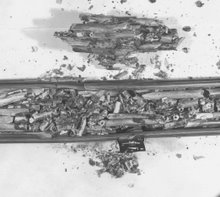By way of introduction here are a few sentences. We are talking about commercial or military atomic power. We must realize that at this stage the game is run by finance and marketing types. And if the so-called technical experts are not producing the proper sentences, the marketers will find others who will do so. In the following paragraphs I refer to clowns and that is not nice or even accurate. In reality they were a gang of obsequious, cunning performers and they were well rewarded for their antics. On one occasion, a bright young investigator, fresh out of MIT was told, “This not school!”
Of course I will not cover all of the details here. Those who choose may read the referenced FLECHT reports. FLECHT is Full Length Emergency Cooling Heat Transfer. A FLECHT heat transfer assembly is a 7 x 7 array of PWL simulated fuel rods (electrically heated) that were 12 feet long.
Two runs are discussed here. Except for Farman’s note (below) the run with stainless steel cladding has been unreported (at least I have no other records). It was a mess. However, it is also useful with my supplemental reporting herein for comparison of the behavior of zircaloy clad heaters in a subsequent test.
Here is some quick background. A FLECHT test consists of heating the test assembly to a temperature in the range of 2000 degrees Fahrenheit and then flooding the upright assembly from the bottom up and monitoring the cladding temperatures at various elevations as the flooding proceeds. The temperatures are monitored by thermocouples that are mounted within the heaters at several elevations. Also, the heaters are built with a profiled power distribution so that more power is at the central regions than at the ends. The flooding temperature is determined in the high power (central) region.
In the stainless steel test, an error led to monitoring the temperature of a lower power region for control of the onset of flooding. The result was that the heat transfer assembly was overheated and almost all of the heaters failed (burned out) at greater than 2500 degrees Fahrenheit. However, all of the cladding remained intact. Indeed, except for discoloration and warping, the assembly was in fairly decent shape. There was also melting of braze alloy from the spacer grids in the high power region, but this was not sufficient to interfere with the flow channels between the stainless steel heaters.
It is unfortunate that the assembly was not photographed. However, as is usually the case, although there was a lot of finger pointing, in the long run the forces in command chose to bury this event. Even with the mess and the lack of detailed reporting, it was a great adventure. I fortunately was not running the show, however, I had a grandstand seat! I’ll dwell on that at another time.
Anyway, Dick Farman produced a two page document that I have managed to preserve. Here it is. Click on it to enlarge and then press your back key to return here.

 So, all of the above took place on April 18, 1969.
So, all of the above took place on April 18, 1969.Well, I wound up running the test floor operations. On December 11, 1970, I was running FLECHT Test No. 9573, an assembly with ziracloy cladding that took off! And it was a good thing (for me) that I knew more about this racket than the clowns who were administering the project from down the road. Following the great take off, I quickly analyzed the charts, produced the following memo, and most important of all, I got it immediately distributed! The clowns down the street did not like this memo, but there was not a lot they could do about it. Here is the text of the memo and it is followed by a less clear (but readable) copy of the original document.


Among aspects that the clowns detested, was my insistence that the run produced valid data up to the time when failure of the heaters began. They invented the fiction that negative heat transfer coefficients were anomalous. In fact, the heat transfer coefficients were very real. They were negative because with the heat of reaction from high temperature oxidation of the ziracloy cladding, the heater became a heat sink as heat was transferred from the reacting surface inward to the very hot , but cooler heater internals.
Here is a memo that I faxed to the NRC a few years ago. (I have no record of the date).
 For now, this wraps up this entry. Clearly, hot zircaloy takes-0ff in water-steam, whether the clowns like it or not.
For now, this wraps up this entry. Clearly, hot zircaloy takes-0ff in water-steam, whether the clowns like it or not.


No comments:
Post a Comment